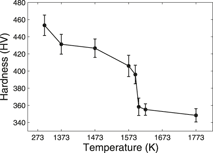Crossref Citations
This article has been cited by the following publications. This list is generated based on data provided by
Crossref.
Alfonso, A.
Juul Jensen, D.
Luo, G.-N.
and
Pantleon, W.
2014.
Recrystallization kinetics of warm-rolled tungsten in the temperature range 1150–1350 °C.
Journal of Nuclear Materials,
Vol. 455,
Issue. 1-3,
p.
591.
Xu, Xiaofeng
Zhao, Yuguang
Wang, Xudong
Zhang, Yangyang
and
Ning, Yuheng
2016.
Effect of rapid solid-solution induced by electropulsing on the microstructure and mechanical properties in 7075 Al alloy.
Materials Science and Engineering: A,
Vol. 654,
Issue. ,
p.
278.
Zhu, R.
and
Tang, G.
2017.
The improved plasticity of NiTi alloy via electropulsing in rolling.
Materials Science and Technology,
Vol. 33,
Issue. 5,
p.
546.
Kang, Kejia
Tu, Rong
Luo, Guoqiang
Zhang, Jian
Zhu, Jiawen
Shen, Qiang
and
Zhang, Lianmeng
2018.
Mechanical, electrical and thermal properties at elevated temperature of W-Si-C multi-phase composite prepared by arc-melting.
International Journal of Refractory Metals and Hard Materials,
Vol. 75,
Issue. ,
p.
101.
Sheng, Yinying
Hua, Youlu
Wang, Xiaojian
Zhao, Xueyang
Chen, Lianxi
Zhou, Hanyu
Wang, James
Berndt, Christopher
and
Li, Wei
2018.
Application of High-Density Electropulsing to Improve the Performance of Metallic Materials: Mechanisms, Microstructure and Properties.
Materials,
Vol. 11,
Issue. 2,
p.
185.
Waryoba, Daudi
Islam, Zahabul
Wang, Baoming
and
Haque, Aman
2019.
Low temperature annealing of metals with electrical wind force effects.
Journal of Materials Science & Technology,
Vol. 35,
Issue. 4,
p.
465.
Gupta, Aman
Khatirkar, Rajesh Kisni
Dandekar, Tushar
Jha, Jyoti Shankar
and
Mishra, Sushil
2019.
Recrystallization behavior of a cold rolled Ti–15V–3Sn–3Cr–3Al alloy.
Journal of Materials Research,
Vol. 34,
Issue. 18,
p.
3082.
Shi, Wei Ning
Zhou, Hai Fei
and
Zhang, Xin Fang
2020.
Rapid Dissolution of Secondary Phase in Cold-Rolling Al-Cu-Mg Alloy by Electropulsing Treatment.
Materials Science Forum,
Vol. 990,
Issue. ,
p.
3.
Wu, Junjie
Liao, Chengzhi
Yang, Yi
Yang, Gang
and
Wu, Mingxia
2020.
Effects of Electropulsing Treatment on Microstructure and Properties of Cemented Carbide (WC-15Co).
Metallurgical and Materials Transactions A,
Vol. 51,
Issue. 12,
p.
6759.
Waryoba, Daudi
Islam, Zahabul
Wang, Baoming
and
Haque, Aman
2020.
Recrystallization mechanisms of Zircaloy-4 alloy annealed by electric current.
Journal of Alloys and Compounds,
Vol. 820,
Issue. ,
p.
153409.
Waryoba, Daudi
Islam, Zahabul
Reutzel, Ted
and
Haque, Aman
2020.
Electro-strengthening of the additively manufactured Ti–6Al–4V alloy.
Materials Science and Engineering: A,
Vol. 798,
Issue. ,
p.
140062.
Bhuyan, D.
Pandey, R. K.
Ojha, S. N.
Sastry, G. V. S.
Choudhary, H.
Sharma, A.
and
Manna, R.
2021.
Recovery of Ductility in Ultrafine-Grained Low Carbon Steel Processed by Electropulsing.
Metallurgical and Materials Transactions A,
Vol. 52,
Issue. 7,
p.
2992.
Raut, P.
Fuloria, D.
Baka, S.
Chatterjee, S.
Ghosh, C.
Venkatramani, N.
and
Samajdar, I.
2022.
Electropulsing-induced plastic deformation in an interstitial free steel.
Materials Science and Technology,
Vol. 38,
Issue. 2,
p.
90.
HU, Zhen-shang
and
Liao, Cheng-zhi
2022.
Improvement of Tensile Property of Slm-Produced Tc4 Alloy after Treatment of Electro-Pulsing.
SSRN Electronic Journal ,
Ren, Zhongkai
Guo, Xiongwei
Liu, Xiao
Ma, Xiaobao
Jiang, Shuyong
Bian, Liping
Wang, Tao
and
Huang, Qingxue
2022.
Effect of pulse current treatment on interface structure and mechanical behavior of TA1/304 clad plates.
Materials Science and Engineering: A,
Vol. 850,
Issue. ,
p.
143583.
Zhou, Lejun
Wu, Houfa
Wang, Wanlin
Luo, Hao
Yan, Xiong
and
Yang, Yang
2022.
Influence of Al2O3 on the electrical conductivity and structure of calcium-silicate-based melts.
Ceramics International,
Vol. 48,
Issue. 1,
p.
232.
Dong, Yuang
Ben, Dandan
Yang, Huajie
Shao, Xiaohong
Wang, Xuegang
and
Zhang, Zhefeng
2022.
Regulating the Tensile Properties of a Nano‐Lamellar Austenitic Stainless Steel via Cryogenic Electropulsing.
Advanced Engineering Materials,
Vol. 24,
Issue. 8,
Rahman, Md Hafijur
Oh, Hajin
Waryoba, Daudi
and
Haque, Aman
2023.
Room temperature control of grain orientation via directionally modulated current pulses.
Materials Research Express,
Vol. 10,
Issue. 11,
p.
116521.
Wei, Lai
Xu, Xiaofeng
Zhao, Yang
Yan, Xudong
Zhou, Yachong
Yu, Yongqiang
and
Wu, Zhicheng
2023.
Rapid Spheroidization Process of S Phase (Al2CuMg) in the As-Cast 2024 Al Alloy Induced by High-Energy Electropulsing.
Materials,
Vol. 16,
Issue. 21,
p.
6939.
Lee, Seong Ho
Bae, Min Hwa
Yu, Jinyeong
Cheon, Seho
Won, Jong Woo
Kim, Sang-Hoon
and
Lee, Taekyung
2024.
Electropulsing anisotropy of cold-rolled Grade 2 titanium sheet: Effect of electric current direction on recrystallization and hardness.
Journal of Materials Research and Technology,
Vol. 31,
Issue. ,
p.
2249.



